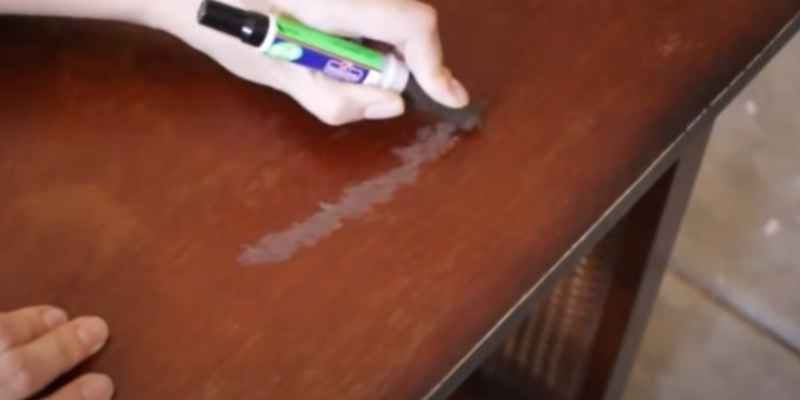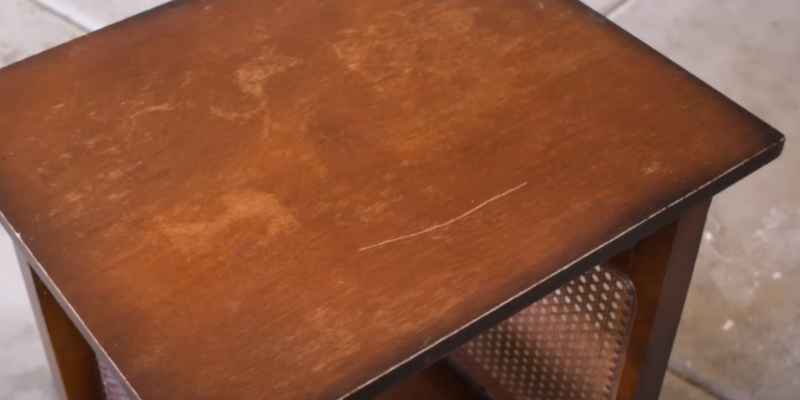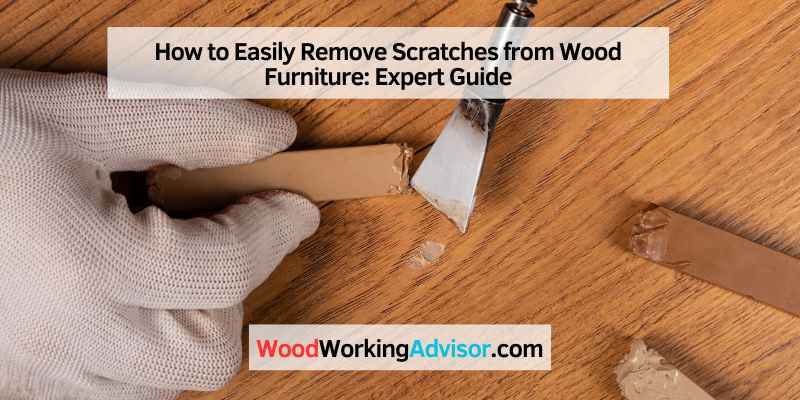To remove scratches from wood furniture, apply a mixture of lemon juice and olive oil and buff the affected area with a soft cloth. This simple technique helps to restore the furniture’s shine and minimize the appearance of scratches.
Wood furniture can easily get scratched due to daily use or accidents. However, there’s no need to worry as there are effective ways to get rid of these unsightly marks and bring back the furniture’s original beauty. We will explore some easy methods to remove scratches from wood furniture using common household items.
By following these steps, you can save money on professional repairs and keep your wood furniture looking good as new.
Understanding Scratches On Wood Furniture
Scratches on wood furniture can be unsightly, but they can be easily removed with a few simple steps. By using household items like olive oil or mayonnaise, you can gently buff out the scratches and restore the beauty of your wood furniture.
Wood furniture adds warmth and beauty to any home, but over time, scratches can mar its appearance. Fortunately, removing scratches from wood furniture is a relatively simple process that can restore its original luster. Before diving into the remedy, it’s important to understand the different types of scratches and their causes. This knowledge allows you to tailor your approach and achieve the best results. So let’s delve into the world of wood furniture scratches and learn how to deal with them effectively.
Different Types of Scratches
When it comes to scratches on wood furniture, not all are created equal. Different types of scratches require different solutions. Understanding these variations will help you identify the appropriate method for repairing the damage.
• Superficial Scratches: These are minor, shallow scratches that affect only the surface of the wood. They often appear as light, thin lines and do not penetrate deeply into the furniture.
• Deep Scratches: Unlike superficial scratches, deep scratches are more severe and noticeable. They can penetrate through the finish and into the wood itself, making them more challenging to remove.
• Heat Marks: Heat marks are caused by exposure to heat sources without proper protection. They manifest as white or discolored patches on the wood’s surface, and they can be particularly stubborn to remove.
• Gouges: Gouges occur when a piece of wood is forcefully removed from the furniture, leaving behind a noticeable dent or hole. These types of scratches require a different approach to repair.
Causes of Scratches
Understanding the causes of scratches on wood furniture is the key to preventing future damage. By knowing how these scratches occur, you can take proactive measures to protect your furniture.
• Accidental Impact: Accidental impact from sharp objects or rough use can lead to scratches on wood furniture. Carelessness or mishandling can easily result in unsightly marks.
• Pet Claws: Our furry friends might bring joy to our lives, but their claws can wreak havoc on wood furniture. Pet scratches are a common and unfortunate cause of damage.
• Improper Cleaning: The cleaning products we use can also be a culprit behind scratches. Using abrasive materials or incorrect techniques may leave scratches on the wood’s surface.
• Moving Furniture: Moving furniture from one place to another can cause scratches if the furniture is not properly protected or handled with care.
• Lack of Protective Measures: If you don’t take preventive measures to safeguard your wood furniture, it’s more prone to scratches. Simple actions like using coasters, tablecloths, or furniture pads can go a long way in protecting your investments.
Now that we’ve explored the different types of scratches and their causes, we can move on to effective solutions for removing scratches from wood furniture. Stay tuned for our next blog post on this topic where we will share DIY remedies and professional treatments to restore your furniture’s beauty.

Essential Tools And Materials
Remove scratches from wood furniture effortlessly with essential tools and materials. Restore the beauty of your furniture with these simple steps.
Syntax: Sanding Tools
When it comes to removing scratches from wood furniture, having the right tools at hand is essential. One of the first tools you’ll need is sandpaper. Sanding helps to smooth out the surface of the wood and get rid of any blemishes. There are different grits of sandpaper available, ranging from coarse to fine. Coarse sandpaper, such as 80 grit, is perfect for removing deep scratches, while finer sandpaper, like 220 grit, is better for a final smooth finish. Make sure to have a variety of sandpaper grits on hand to tackle different levels of scratches on your wood furniture.
Syntax: Wood Filler
If you have deeper scratches or gouges in your wood furniture, using wood filler can be a great option. Wood fillers are specially formulated compounds that help to fill in damaged areas, restoring the smooth surface of your furniture. When choosing a wood filler, look for one that matches the color of your wood. This way, once the filler is applied and dried, it will seamlessly blend with the surrounding wood. To apply the wood filler, use a putty knife or a scraper to fill in the scratch, ensuring it is level with the rest of the surface. Once the filler has dried, you can sand it down to achieve a smooth finish.
Syntax: Stain And Sealant
After you have sanded away the scratches and filled in any deeper ones, it’s time to restore the color and protect the surface with a stain and sealant. Stains can help to enhance the natural beauty of the wood, while sealants provide a protective layer that guards against future scratches and damage. When choosing a stain, opt for one that matches the original shade of your wood furniture or go for a darker stain for a deeper, richer look. Apply the stain using a brush or a clean cloth, following the wood grain. Once the stain is dry, add a protective layer of sealant to ensure your furniture stays looking its best for years to come.
Preparing The Wood Surface
To remove scratches from wood furniture, start by preparing the wood surface. Gently sand the affected area with fine-grit sandpaper, following the direction of the grain. Wipe away any dust with a soft cloth before applying a suitable wood filler or touch-up marker to blend in the scratch.
Cleaning The Furniture
To properly prepare the wood surface for scratch removal, the first step is to thoroughly clean the furniture. Cleaning will not only remove dust and dirt but also any built-up grime that may have accumulated over time. Here’s how to do it:
- Dust the furniture: Begin by gently dusting the furniture with a soft cloth or feather duster. This will help remove loose particles that can scratch the wood during the cleaning process.
- Mix a mild cleaning solution: In a bucket or spray bottle, create a solution by combining warm water and a few drops of dish soap or wood cleaner. Avoid using harsh chemicals or abrasive cleaners that can damage the wood.
- Wipe the surface: Dip a clean cloth into the cleaning solution and wring out any excess liquid. Gently wipe the entire surface of the wood furniture, making sure to reach into corners and crevices.
- Rinse with clean water: After wiping, dampen a separate cloth with clean water and use it to rinse off any remaining soap residue. Make sure to thoroughly remove all traces of the cleaning solution.
- Dry the furniture: Finally, use a dry, lint-free cloth to dry the furniture completely. Moisture can damage wood, so be sure to remove any excess moisture to prevent warping or discoloration.
Removing Old Finishes
If your wood furniture has an old finish that needs to be removed before addressing the scratches, follow these steps:
- Gather the necessary materials: You will need sandpaper in various grits, a paint scraper or putty knife, and chemical stripper if necessary.
- Sand the surface: Begin by using coarse sandpaper to remove the existing finish. Sand in the direction of the wood grain, applying even pressure. Gradually switch to finer grit sandpaper to achieve a smooth surface.
- Use a paint scraper or putty knife: If there are stubborn or thick layers of finish that cannot be easily sanded, carefully scrape them off using a paint scraper or putty knife. Be cautious not to gouge or damage the wood.
- Apply chemical stripper (if needed): If the finish is particularly stubborn, you may need to use a chemical stripper. Follow the manufacturer’s instructions for application and use caution when handling these products.
- Remove residue: Once the finish has been successfully removed, wipe away any residue with a clean cloth or sponge dampened with water. Make sure the surface is completely clean and free of any debris before proceeding.
Repairing Minor Scratches
Remove minor scratches from wood furniture with these easy steps. Use a mixture of olive oil and vinegar to gently buff the scratch, then wipe away any excess. Finish by applying a wood polish for a flawless look.
Sanding The Affected Area
Sanding is an effective method for repairing minor scratches on your wood furniture. Start by gently sanding the surface of the affected area using fine-grit sandpaper. Sanding helps to smooth out the scratch and prepare it for the next step of the repair process. Be sure to sand in the direction of the wood grain to achieve the best results. Once you have sanded the scratch, wipe away any debris or dust with a clean cloth.
Applying The Wood Filler
Wood filler is an ideal solution for filling in minor scratches and restoring the smooth surface of your wood furniture. First, choose a wood filler that matches the color of your furniture. Using a putty knife or a similar tool, apply a small amount of wood filler to the scratch. Smooth it over the entire affected area, ensuring it is level with the surrounding wood surface. Allow the wood filler to dry completely, following the manufacturer’s instructions.

Fixing Deep Scratches
Learn how to easily remove deep scratches from your wood furniture with these simple steps. With the right technique and a few household items, you can restore your furniture’s appearance to its original beauty in no time.
Introduction
Fixing deep scratches on wooden furniture can be a daunting task, but with the right techniques and tools, you can restore your furniture to its former glory. In this section, we will explore how to repair deep scratches using wood putty and how to match the stain for a seamless finish.
Repairing With Wood Putty
If you have deep scratches on your wood furniture, using wood putty is an effective way to fill in the damaged area. Follow these steps to repair the scratches:
- Start by cleaning the scratched area with a mild soap and water solution to remove any dirt or debris.
- Using a putty knife, apply a generous amount of wood putty to the scratch, making sure to fill it completely.
- Smooth out the putty with the putty knife, removing any excess and ensuring it is level with the surface of the furniture.
- Leave the putty to dry according to the manufacturer’s instructions.
- Once dry, lightly sand the repaired area using fine-grit sandpaper until it is smooth and blends with the surrounding wood.
Matching The Stain
To achieve a seamless finish, it’s essential to match the stain of the repaired area with the rest of the furniture. Here’s how you can do it:
- Start by identifying the type of stain or finish that was used on your furniture. This information can usually be found on the manufacturer’s website or by contacting the furniture store.
- Purchase a matching stain or finish from your local home improvement store or online retailer.
- Before applying the stain to the repaired area, test it on a small, inconspicuous area of the furniture to ensure it matches perfectly.
- If the stain matches, carefully apply it to the repaired area using a clean cloth or a brush, following the manufacturer’s instructions.
- Allow the stain to dry completely before applying a protective finish, such as a clear varnish or polyurethane, to ensure the repaired area blends seamlessly with the rest of the furniture.
By following these steps and taking your time, you can effectively fix deep scratches on your wood furniture and restore its original beauty.
Conclusion
To conclude, effectively removing scratches from wood furniture requires the right techniques and tools. By following the steps outlined in this guide, you can restore the beauty of your furniture and extend its lifespan. Remember, prevention is key, so consider using protective pads and regular maintenance to avoid future scratches.
With patience and care, you can maintain your wood furniture’s natural beauty for years to come.


